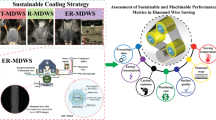Abstract
This paper investigated the influence of three micro electrodischarge milling process parameters, which were feed rate, capacitance, and voltage. The response variables were average surface roughness (R a ), maximum peak-to-valley roughness height (R y ), tool wear ratio (TWR), and material removal rate (MRR). Statistical models of these output responses were developed using three-level full factorial design of experiment. The developed models were used for multiple-response optimization by desirability function approach to obtain minimum R a , R y , TWR, and maximum MRR. Maximum desirability was found to be 88%. The optimized values of R a , R y , TWR, and MRR were 0.04, 0.34 μm, 0.044, and 0.08 mg min−1, respectively for 4.79 μm s−1 feed rate, 0.1 nF capacitance, and 80 V voltage. Optimized machining parameters were used in verification experiments, where the responses were found very close to the predicted values.
Similar content being viewed by others
References
Madou MJ (2002) Fundamentals of micro fabrication. The science of miniaturization, 2nd edn. CRC Press LLC, Boca Raton
Hsu TR (2002) MEMS & Microsystems- Design and Manufacture. McGraw Hill.
Ehmann KF, DeVor RE, Kapoor SG (2002) Micro/meso-scale mechanical manufacturing- opportunities and challenges. Proc JSME/ASME Int Conf Mater Process 1:6–13
Lim HS, Wong YS, Rahman M, Lee MKE (2003) A study on the machining of high-aspect ratio micro-structures using micro-EDM. J Mater Process Technol 140:318–325 doi:10.1016/S0924-0136(03)00760-X
Fleischer J, Kotschenreuther J (2007) The manufacturing of micro molds by conventional and energy-assisted processes. Int J Adv Manuf Technol 33:75–85 doi:10.1007/s00170-006-0596-1
Puertas I, Luis CJ (2004) A study of optimization of machining parameters for electrical discharge machining of boron carbide. Mater Manuf Process 19(6):1041–1070
Lin YC, Cheng CH, Su BL, Hwang LR (2006) Machining characteristics and optimization of machining parameters of SKH 57 high-speed steel using electrical-discharge machining based on Taguchi method. Mater Manuf Process 21(8):922–929
Uhlmann E, Piltz S, Jerzembeck S (2005) Micro-machining of cylindrical parts by electrical discharge grinding. J Mater Process Technol 160:15–23 doi:10.1016/j.jmatprotec.2004.02.054
Han F, Jiang J, Yu D (2007) Influence of machining parameters on surface roughness in finish cut of WEDM. Int J Adv Manuf Technol 34(5–6):538–546
Chiang K (2007) Modeling and analysis of the effects of machining parameters on the performance characteristics in the EDM process of Al2O3+TiC mixed ceramic. Int J Adv Manuf Technol 37(5–6):528–533
Liao YS, Huang JT, Chen YH (2004) A study to achieve a fine surface finish in wire-EDM. J Mater Process Technol 149:165–171 doi:10.1016/j.jmatprotec.2003.10.034
Salonitis K, Stournaras A, Stavropoulos P, Chryssolouris G (2007) Thermal modeling of the material removal rate and surface roughness for die-sinking EDM. Int J Adv Manuf Technol ISSN 0268-3768 (Print) 1433-3015 (Online)doi:10.1007/s00170-007-1327-y
Her M-G, Weng F-T (2001) Micro-hole machining of copper using the electro-discharge machining process with a tungsten carbide electrode compared with a copper electrode. Int J Adv Manuf Technol 17:715–719 doi:10.1007/s001700170116
Kim YT, Park SJ, Lee SJ (2005) Micro/meso-scale shapes machining by micro EDM process. Int J Prec Engin Manuf 6(2):5–7
Ozgedik A, Cogun C (2006) An experimental investigation of tool wear in electric discharge machining. Int J Adv Manuf Technol 27:488–500 doi:10.1007/s00170-004-2220-6
Son SM, Lim HS, Kumar AS, Rahman M (2007) Influences of pulsed power condition on the machining properties in micro EDM. J Mater Process Technol 190:73–76 doi:10.1016/j.jmatprotec.2007.03.108
Lee SH, Li XP (2001) Study of the effect of machining parameters on the machining characteristics in electrical discharge machining of tungsten carbide. J Mater Process Technol 115:344–358 doi:10.1016/S0924-0136(01)00992-X
Chen SL, Yan BH, Huang FY (1999) Influence of kerosene and distilled water as dielectrics on the electric discharge machining characteristics of Ti-6Al-4V. J Mater Process Technol 87:107–111 doi:10.1016/S0924-0136(98)00340-9
Chung KD, Kim BH, Chu CN (2007) Micro electrical discharge milling using deionized water as a dielectric fluid. J Micromech Microeng 17:867–874 doi:10.1088/0960-1317/17/5/004
Ghoreishi M, Atkinson J (2002) A comparative experimental study of machining characteristics in vibratory, rotary and vibro-rotary electrodischarge machining. J Mater Process Technol 120:374–384 doi:10.1016/S0924-0136(01)01160-8
Author information
Authors and Affiliations
Corresponding author
Rights and permissions
About this article
Cite this article
Mehfuz, R., Ali, M.Y. Investigation of machining parameters for the multiple-response optimization of micro electrodischarge milling. Int J Adv Manuf Technol 43, 264–275 (2009). https://doi.org/10.1007/s00170-008-1705-0
Received:
Accepted:
Published:
Issue Date:
DOI: https://doi.org/10.1007/s00170-008-1705-0




